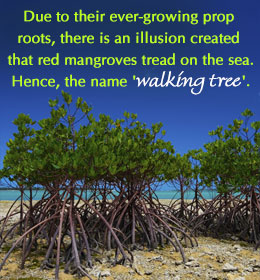Though not considered an 'eye candy' tree, the Red Mangrove has its own reasons to be one of the most important trees for mankind. Buzzle enlists a few of the most vital reasons to render this tree important.

Flowing with the FlowQuite strangely, if the pencil-shaped fruits of the Red Mangrove tree fall into the sea, they keep on floating on the water for almost a year, until they strike against a landmass, where they grow into new trees naturally.
Scientific Name: Rhizophora mangle
Kingdom: Plantae
Order: Malpighiales
Family: Rhizophoraceae
Genus: Rhizophora
Species: R. mangleMangrove trees are found in almost all tropical and sub-tropical regions. Some countries in Asia, Africa, Oceania, and America are home to various types of mangrove trees. More specifically, North, South, and Central America have these trees that are known to have great adaptation capability. There are numerous species of mangroves that thrive in America, of which, about three are found in the US, where it is christened as the Red mangrove. They are easily recognized by their unique root network which are visible over the ground, rather than underground. These roots are called prop roots. Their key function is to carry water to the roots present underneath the ground. Likewise, there are numerous other such facts which will grab your attention, listed in the following.Interesting Red Mangrove Tree Facts
 H
Hawaii, Florida, Puerto Rico, and the Virgin Islands are home to an exotic array of red mangroves. Red mangroves are not tolerant to frost. The plant is amply found in southeast US, tropical parts of America, and the Caribbean.
 T
These shrub-like trees are vital to the ecosystem, as they provides a haven for the submerged sea creatures, with the aid of the roots present under the water.
 T
They are also known to protect against natural calamities like hurricane flood waters and storms, by averting erosion of soil.
 I
It is believed that if and when sea levels rise, it will prompt these trees towards land. This, perhaps, will not be adapted by them, leading to their extinction.
 S
Some botanists have also unanimously declared this mangrove member as the
true mangrove.
 T
This tree, which is also taken to be as a shrub by many, grows in conditions which are otherwise adverse to other tree types. It grows in very soft land near the coast, in shallow waters. Quite obviously, it grows in extreme saline water.
 I
It has undergone some significant adaptations to be able to survive in such extreme conditions. Its leaves are so designed that they retain freshwater as much as possible, by not losing the same in the process of evaporation. The leaves are thick and waxy.
 O
One of the key features is the
prop root, which not only carries water and oxygen to the underground root network, but also forms a strong support system which allows the tree to stand in soft mud and shallow water.
 A
Apart from serving as a mini-ecosystem in itself, this tree is put to immense use even by humans. The dark red wood makes one of the most efficient type of charcoal.
 T
This mangrove variety can withstand the changing temperature in water. It can also well adapt to the frequently changing humidity level, and the level of salinity in the water. This makes it the toughest of all the mangrove trees.
 S
Some interesting names associated with the red mangrove are:
mangle dulce,
mangle rojo,
thiri wai,
apareiba, besides many others. However, the scientific name
Rhizophora mangle has an underlying meaning. 'Rhizo' denotes roots and 'phora' stands for bear.
 A
Amongst the many varieties of mangrove trees that are prevalent, the red mangrove is the most widespread because of its unique propagation of seeds.
 T
This variety of mangrove is one of the most easily cultivated trees. All it requires is some care on the part of the grower. Just by mimicking the growing conditions, one can have this right at one's home. It can be grown as an aquarium plant too.
 T
The prerequisites for the plant's growth are
light,
water,
humidity, and
temperature conditions. The temperature should be warm, light exposure should ideally be close to 10 - 12 hours each day, and humidity level should be no less than 50%. The growth rate of this plant is heavily dependent on proper conditions around it.
 I
In contrast to its use as charcoal, the red mangrove is also used in the process of reforestation in coastal areas. It is also used as a cure for stomach ulcers, and also in the manufacture of dyes.Despite its widespread usability and its contribution in maintaining a balanced ecosystem in coastal regions, there seems to be some amount of threat in the survival of the red mangrove. The factors are multiple, including natural processes like water logging, changing environment, agriculture, etc. However, the root cause can be attributed to over exploitation of this tree, which if minimized, can save it from becoming extinct.






 Flowing with the FlowQuite strangely, if the pencil-shaped fruits of the Red Mangrove tree fall into the sea, they keep on floating on the water for almost a year, until they strike against a landmass, where they grow into new trees naturally.Scientific Name: Rhizophora mangle
Flowing with the FlowQuite strangely, if the pencil-shaped fruits of the Red Mangrove tree fall into the sea, they keep on floating on the water for almost a year, until they strike against a landmass, where they grow into new trees naturally.Scientific Name: Rhizophora mangle